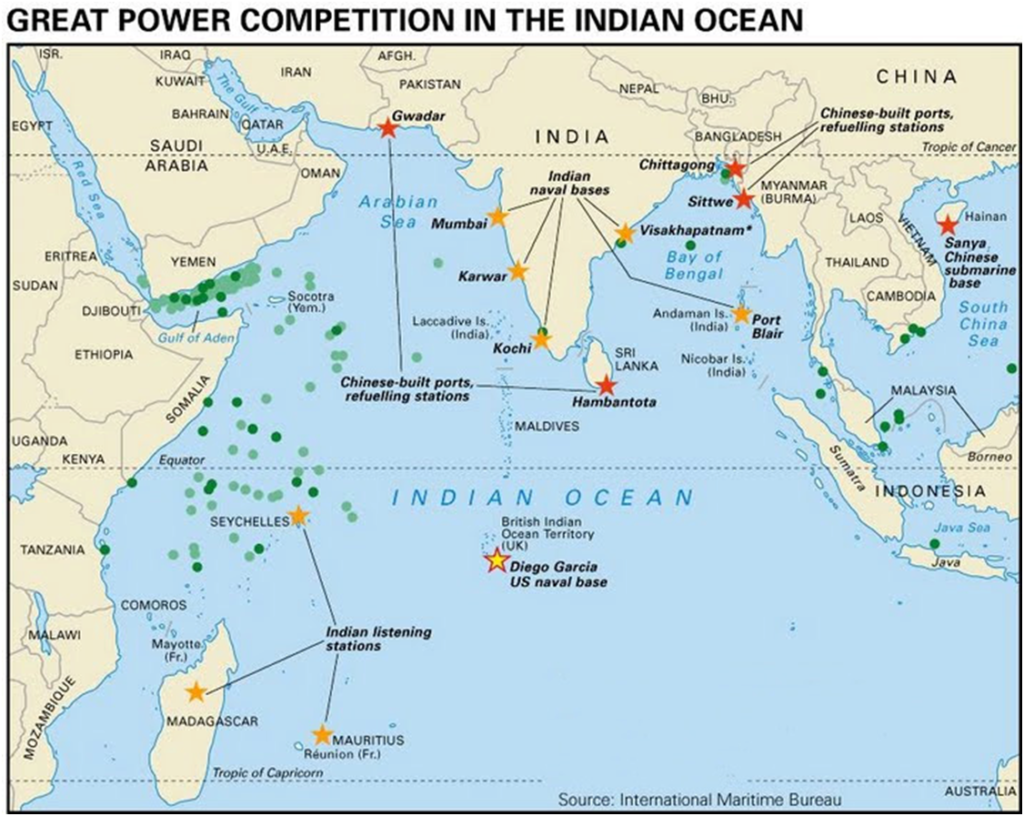MEANING
The String of pearls is a geopolitical theory on potential Chinese intentions in the Indian Ocean region.
It refers to the network of Chinese military and commercial facilities and relationships along its sea lines of communication, which extend from the Chinese mainland to Port Sudan.
The sea lines run through several major maritime choke points such as the Strait of Mandeb, the Strait of Malacca, the Strait of Hormuz, and the Lombok Strait as well as other strategic maritime centers in Pakistan, Sri Lanka, Bangladesh, the Maldives, and Somalia.
Must read: Rise of the People’s Republic of China (PRC) as a great power and its implications

WHAT BEIJING IS DOING ?
Beijing is already well-known as an all-weather friend of India’s arch rival, Pakistan and has developed the Pakistani port in Gwadar. In addition to this, China has also made substantial investments in Chittagong in Bangladesh, Kyaukphyu in Myanmar, and Hambantota in Sri Lanka. It is also developing links with small nations like Nepal and Bhutan that are strategically located to India’s proximity.
ORIGIN OF THE CONCEPT
The term as a geopolitical concept was first used in an internal US Department of Defence report, “Energy Futures in Asia.”
The emergence of the String of Pearls is indicative of China’s growing geopolitical influence through concerted efforts to increase access to ports and airfields, expand and modernize military forces, and foster stronger diplomatic relationships with trading partners.
Must read: Belt and Road Initiative – One Belt One Road
REASONS BEHIND CHINESE MOVES
China cannot secure its dominance in the South China Sea without expanding its presence in the Indian Ocean. For a simple reason. A blockade of the Strait of Malacca by the US and its allies will cut China off from Middle East oil supplies and from its “Second Continent” Africa.
That’s why China is shoring up Sri Lanka’s major ports and working feverishly with Pakistan to build an alternative route to Middle East and Africa—the China-Pakistan Economic Corridor(CPEC).
Must read: Border dispute between India and China
INDIA’S REPLY – IRON CURTAIN
Backed by a burgeoning economy, New Delhi too aspires to be hailed as a true blue water navy, and they will always deter the Chinese aspirations in the IOR. To live up to this very notion, India too is answering boldly by juxtaposing its presence alongside that of China in the IOR — a strategy that has been termed as Iron Curtain.
India is presently exchanging dialogues with Nepal, Bhutan, and Bangladesh to identify the areas of investments in these countries. .
The Tripartite Technical Expert Group (TTEG) consisting of Indonesia, Malaysia, and Singapore that administers the Malacca Straits has received substantial monetary aid from India. By the virtue of which the group has involved India’s naval expertise to survey shipwrecks in the area.
Militarily too India has expanded its presence in the IOR by setting up listening posts in Seychelles, Mozambique, Madagascar, and Mauritius. India has also gained berthing rights in Oman and Vietnam.
External link: https://en.wikipedia.org/wiki/String_of_Pearls_(Indian_Ocean)#:~:text=The%20String%20of%20Pearls%20is,in%20the%20Horn%20of%20Africa.
